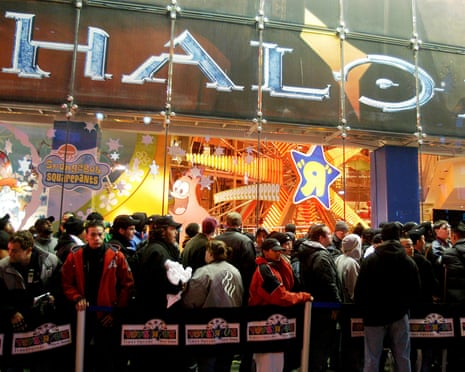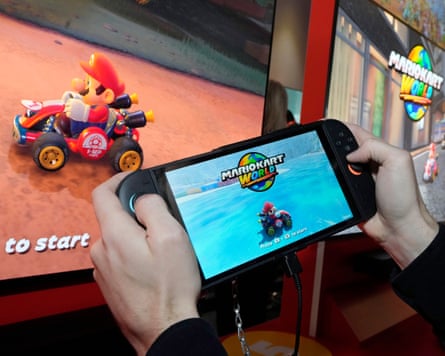## The Console Craze is Back: Did You Feel the Switch 2 Buzz at Midnight?
Remember the thrill of a midnight launch? The breathless anticipation, the line snaking down the block, the collective gasp as the first console powered up? Nintendo hasn’t exactly given us that feeling in a while. But hold onto your hats, gamers, because the Switch 2 launch is bringing back the magic.

According to The Guardian, midnight releases are making a comeback, fueled by the hype surrounding Nintendo’s latest console. We’re talking about dedicated fans braving the night, ready to be among the first to experience the future of gaming.

A New Era of Launches: Nintendo Switch 2 and the Quiet Revolution

There was a time when certain shops would resemble nightclubs at about midnight: a long queue of excitable people, some of them perhaps too young to be out that late, discussing the excitement that awaits inside. The sight of throngs of gamers looking to get their hands on the latest hardware when the clock strikes 12 is growing increasingly rare. But if you happen to walk by a Smyths toy shop at midnight on 4 June, you may encounter a blast from the past: excitable people, most in their teens or 20s, possibly discussing Mario Kart. They will be waiting to buy the Nintendo Switch 2, the first major games console launch since 2020 and potentially the biggest of all time. What’s particularly notable about this launch isn’t the queues but just how few there will be. About 10 years ago, the midnight launch fad started to fade away. More and more players were buying digital copies of games, which meant they could download and start playing them straight away without leaving their homes.
This time around, Smyths is the only UK chain taking part. Even in the States, the home of frenzied launch-day consumerism, only Best Buy and Nintendo’s own stores in San Francisco and New York have confirmed midnight openings. This is a stark contrast to the noughties and early 2010s. Back then, thanks to the vast global success of the PlayStation, Wii and Xbox consoles, video game launch events for titles such as Call of Duty, Halo and Grand Theft Auto were supported by thousands of stores around the world, and the biggest were extravagantly stage-managed. Microsoft’s Halo 3 launch events in the US were accompanied by dozens of actors dressed as space marines; Bill Gates himself showed up at the Seattle branch of Best Buy. In the UK, the Call of Duty Ghosts event at the Westfield in Stratford hired a drill sergeant to yell at customers. “My favourite was Skyrim,” says Greg Weller, who was then the UK marketing manager for Bethesda Softworks. “We got the specs of Game’s flagship store on Oxford Street and covered the whole front with Elder Scrolls artwork. We put a snow machine on the roof, so we made it snow in November on Oxford Street. We had press there, we had a cosplay competition, there was a humongous queue, and so many people were dressed up – they wanted to be part of the story, part of the community.”
A Limited Number of Midnight Events: A Sign of the Times?
Console launches were a major phenomenon on a par with any movie premiere. For the launch of the Xbox One in 2013, Microsoft took over Leicester Square, building a vast Xbox-branded globe in the centre where the musicians Plan B and Katy B performed. A fortnight earlier, Sony took over the Standard High Line hotel in New York and turned it into a giant video game arcade with developers showing off their wares to thousands of gamers. For the stores and game publishers, these lavish launch events increased footfall and generated word of mouth and press coverage. For the fans, they were a way to feel part of something.
“Growing up as a gamer in the 90s, we were quite ostracised for the hobby,” says Rich Thompson, now a developer and founder of Black Rose Studio in Hull. “But then having shops opening at midnight, it was mind-blowing. When Fallout 4 came out, our local Game store hired a DJ; it was a party atmosphere, there were hundreds of us there. I vividly remember people swapping contact details in the queue – you were among your people.”
Focus on Online Engagement: Digital Marketing and Community Building
It wasn’t all fun and games, however. Midnight launches sometimes descended into chaos. “The problem was, you’d have one shop open in a city centre that’s full of people coming out of the pub,” says Thompson. “Drunk people would come into these launches, cause a scene and refuse to leave. I remember a huge fight breaking out at one Fifa launch night. Getting thrown out of a midnight game launch became a badge of honour.”
Gamers Reimagine the Experience: Finding Community Beyond Midnight
The rise of digital gaming and streaming has fundamentally changed how gamers engage with new releases. The convenience of downloading games instantly, coupled with the ability to connect with other players online, has diminished the need for physical gatherings. While traditional launch events still hold a certain appeal, especially for hardcore fans, the industry has shifted its focus towards online engagement and community building.
Online Communities: Finding Your Tribe in the Digital Realm
Gamers have found new ways to connect and celebrate game releases through online communities. Dedicated forums, Discord servers, and social media groups provide platforms for fans to discuss their excitement, share strategies, and build lasting friendships. These virtual spaces have become vital hubs for fostering a sense of belonging and shared passion.
Livestreaming and Social Media: Sharing the Excitement in Real Time
Livestreaming platforms like Twitch and YouTube Gaming have revolutionized the way gamers experience new releases. Watching others play, often with insightful commentary and interaction from viewers, has become a popular alternative to playing solo. Launch day streams generate immense hype, with viewers eagerly tuning in to witness first impressions, gameplay glitches, and epic victories.
The Rise of Indie Games: Unconventional Launch Strategies
The indie game scene has embraced a more unconventional approach to launches. Smaller developers often forgo traditional marketing campaigns and rely on word-of-mouth, social media engagement, and community building to generate buzz. This grassroots approach has proven successful, allowing indie titles to carve out a niche and connect directly with their target audience.
Conclusion
The Guardian’s piece on the Nintendo Switch 2 launch and its revival of the midnight release tradition paints a vivid picture of a gaming landscape in flux. We see a nostalgic yearning for that communal excitement of a physical release, a desire to be part of something bigger than ourselves, even in the age of instant digital downloads. This resurgence speaks volumes about the enduring power of ritual and shared experience, especially in a world increasingly dominated by solitary online interactions.
The success of the Switch 2 launch event isn’t just a win for Nintendo, it’s a signal to the industry at large. It suggests that the magic of physical releases, the thrill of unboxing and the shared anticipation, still holds a special place in the hearts of gamers. Will this spark a trend? Will we see more developers and publishers embracing the midnight launch in the future? It seems highly likely. As technology continues to evolve, the desire for genuine connection and shared experiences will only grow stronger. The Switch 2 launch is a reminder that even in a digital world, the human element remains irreplaceable. It’s a call to embrace the tangible, the communal, and the joy of experiencing something extraordinary alongside fellow enthusiasts.
Let’s not forget the power of a shared passion. The thrill of the midnight launch, the anticipation in the air, the camaraderie of fellow gamers – these are the moments that truly define our gaming culture.